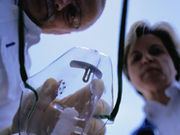NORA cases less likely in small community hospitals, more common outside normal working hours
MONDAY, Oct. 24, 2016 (HealthDay News) — Patient and case characteristics differ for non-operating room anesthesia (NORA) and operating room (OR) anesthesia, according to a study presented at the annual meeting of the American Society of Anesthesiologists, held from Oct. 22 to 26 in Chicago.
Alexander Nagrebetsky, M.D., from John H. Stroger Hospital of Cook County in Chicago, and colleagues conducted a retrospective analysis of data from the National Anesthesia Clinical Outcomes Registry to summarize NORA patient and case characteristics. The cohort included data reported from 2,439 health care facilities.
The researchers identified 5,929,953 NORA cases and 12,387,574 OR cases. Compared with OR patients, the mean age of NORA patients was 3.5 years higher (P < 0.001). Compared with patients with American Society of Anesthesiologists Physical Status (ASA PS) I to II, patients with ASA PS class III to V were more likely to belong to the NORA group (odds ratio, 1.16; P < 0.001). NORA cases were less likely in small community hospitals than university hospitals (odds ratio, 0.67; P < 0.001). NORA cases were more common outside of normal working hours (odds ratio, 1.33; P < 0.001). The most commonly reported NORA procedure was colonoscopy.
“The growth reflects a shift toward safer, less-invasive procedures and tests that still require anesthesia,” a coauthor said in a statement. “It’s important that anesthesia for patients with severe health conditions is provided by physician anesthesiologists who have the extensive training and skill to deliver safe care.”
Copyright © 2016 HealthDay. All rights reserved.








